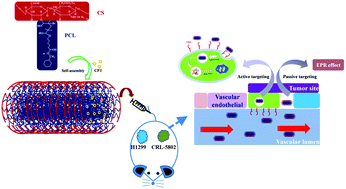Distinct CPT-induced deaths in lung cancer cells caused by clathrin-mediated internalization of CP micelles†
Abstract
We previously synthesized a chondroitin sulfate-graft-poly(ε-caprolactone) copolymer (H-CP) with a high content of poly(ε-caprolactone) (18.7 mol%), which self-assembled in water into a rod-like micelle to encapsulate hydrophobic camptothecin (CPT) in the core (micelle/CPT) for tumor-targeted drug delivery. As a result of the recognition of the micelle by CD44, the micelle/CPT entered CRL-5802 cells efficiently and released CPT efficaciously, resulting in higher tumor suppression than commercial CPT-11. In this study, H1299 cells were found to have a higher CD44 expression than CRL-5802 cells. However, the lower CD44-expressing CRL-5802 cells had a higher percentage of cell death and higher cellular uptake of the micelle/CPT than the higher CD44-expressing H1299 cells. Examination of the internalization pathway of the micelle/CPT in the presence of different endocytic chemical inhibitors showed that the CRL-5802 cells involved clathrin-mediated endocytosis, which was not found in the H1299 cells. Analysis of the cell cycle of the two cell lines exposed to the micelle/CPT revealed that the CRL-5802 cells arrested mainly in the S phase and the H1299 cells arrested mainly in the G2-M phase. A consistent result was also found in the evaluation of γ-H2AX expression, which was about three-fold higher in the CRL-5802 cells than in the H1299 cells. A near-infrared dye, IR780, was encapsulated into the micelle to observe the in vivo biodistribution of the micelle/IR780 in tumor-bearing mice. The CRL-5802 tumor showed a higher fluorescence intensity than the H1299 tumor at any tracing time after 1 h. Thus we tentatively concluded that CRL-5802 cells utilized the clathrin-mediated internalization pathway and arrested in the S phase on exposure to the micelle/CPT; all are possible reasons for the better therapeutic outcome in CRL-5802 cells than in H1299 cells.

- This article is part of the themed collection: 2016 Nanoscale HOT Article Collection

 Please wait while we load your content...
Please wait while we load your content...